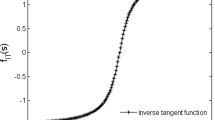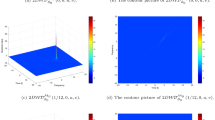Abstract
It has been discovered that (a) the variance of all entries of the ambiguity vector transformed by a (inverse) paired Cholesky integer transformation is reduced relative to that of the corresponding entries of the original ambiguity vector; (b) the higher the dimension of the ambiguity vector, the more significantly the transformed variance will be decreased. The property of variance reduction is explained theoretically in detail. In order to better measure the property of variance reduction, an efficiency factor on variance reduction of ambiguities is defined. Since the (inverse) paired Cholesky integer transformation is generally performed many times for the GNSS high-dimensional ambiguity vector, the computation formula of the efficiency factor on the multi-time (inverse) paired Cholesky integer transformation is deduced. The computation results in the example show that (a) the (inverse) paired Cholesky integer transformation has a very good property of variance reduction, especially for the GNSS high-dimensional ambiguity vector; (b) this property of variance reduction can obviously improve the success rate of the transformed ambiguity vector.

Similar content being viewed by others
References
Cai J, Grafarend EW, Hu C (2009) The total optimal search criterion in solving the mixed integer linear model with GNSS carrier phase observations. GPS Solut 13(3):221–230
Golub GH, Van Loan CF (1993) Matrix computation, 2nd edn. The Johns Hopkins University Press, Baltimore
Grafarend E (2000) Mixed integer-real valued adjustment (IRA) problems. GPS Solut 4:31–45
Hassibi A, Boyd S (1998) Integer parameter estimation in linear models with applications to GPS. IEEE Trans Signal Proc 46:2938–2952
Hofmann-Wellenhof B, Lichtenegger H, Collins J (2001) GPS theory and Practice, 5th edn. Springer, Wien
Hofmann-Wellenhof B, Lichtenegger H, Wasle E (2008) GNSS global navigation satellite systems, GPS, GLONASS, Galileo and more. Springer, Wien
Leick A (2004) GPS satellite surveying, 3rd edn. Wiley, New York
Lou L, Grafarend E (2003) GPS integer ambiguity resolution by various decorrelation methods. Zeitschrift für Vermessungswesen 3:203–210
Strang G, Borre K (1997) Linear algebra, geodesy, and GPS. Cambridge Press, Wellesley
Teunissen PJG (1993) Least-squares estimation of the integer GPS ambiguities. Invited lecture, sect IV theory and methodology. In: IAG general meeting, Beijing
Teunissen PJG (1995) The least-squares ambiguity decorrelation adjustment: a method for fast GPS integer ambiguity estimation. J Geod 70:65–82
Teunissen PJG (1998) Success probability of integer GPS ambiguity rounding and bootstrapping. J Geod 72:606–612
Teunissen PJG (1999) An optimality property of the integer least-squares estimator. J Geod 73:587–593
Teunissen PJG (2000) The success rate and precision of GPS ambiguities. J Geod 74:321–326
Teunissen PJG (2001) The probability distribution of the ambiguity bootstrapped GNSS baseline. J Geod 75:267–275
Teunissen PJG, Kleusberg A (eds) (1998) GPS for geodesy, 2nd edn. Springer, Berlin, pp 262–333
Teunissen PJG, De Jonge PJ, Tiberius CC (1997) The least-squares ambiguity decorrelation adjustment: its performance on short GPS baselines and short observation spans. J Geod 71:589–602
Zhou YM (2011) A new practical approach to GNSS high-dimensional ambiguity decorrelation. GPS Solut 15(4):325–331
Zhou YM, Liu JN (2003) Another form for LAMBDA method. Geo Spat Inf Sci (Quarterly) 6(3):66–70
Zhou YM, Liu JN (2006) Return bootstrapping approach and its reliability. Surv Rev 38(299):368–378
Zhou YM, Liu JN, Liu JY (2005) Return-calculating LAMBDA approach and its search space. Acta Geodaetica et Cartographica Sinica 34(4):300–304
Acknowledgments
This study is supported by the Key Project of National Natural Science Foundation of China (No: 41231174). The authors thank the anonymous reviewers for their detailed comments and valuable suggestions that help us reform the manuscript into the current structure.
Author information
Authors and Affiliations
Corresponding author
Rights and permissions
About this article
Cite this article
Zhou, Y., He, Z. Variance reduction of GNSS ambiguity in (inverse) paired Cholesky decorrelation transformation. GPS Solut 18, 509–517 (2014). https://doi.org/10.1007/s10291-013-0347-3
Received:
Accepted:
Published:
Issue Date:
DOI: https://doi.org/10.1007/s10291-013-0347-3




